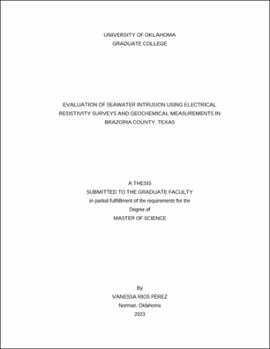| dc.description.abstract | Seawater intrusion is one of the world's leading causes of groundwater contamination in coastal aquifers. In the United States, relatively little research has been conducted in the Gulf Coast Region bordering the state of Texas, even though the coastal zones of this state have been rendered potentially vulnerable to seawater intrusion. Furthermore, most investigations of saltwater intrusion processes globally have focused on numerical modeling experiments and sand-tank experimentations, which highlight the need to acquire reliable geologic information about an aquifer system, and the potential saltwater-freshwater interfaces present in it. Field investigations from geophysical and geochemical approaches present a valid effort to provide an improved spatial understanding of seawater intrusion in coastal aquifers, and a scientific basis for decision-makers and groundwater stakeholders to take appropriate actions for the benefit of water resources and their direct impact on people’s lives.
This study applies electrical resistivity surveys to image the subsurface in Brazoria County, a site selected by analyzing available salinity data of water wells in Texas. Geophysical measurements were collected by using two transects covering the distance between a zone with wells that displayed high and low TDS in the study area, as well as an additional transect located in the surrounding area of a water well that was sampled for this study. Eight groundwater wells were sampled, and geochemical analyses were employed to calibrate and expand the results obtained with the electrical resistivity tomography (ERT). Geochemical indicators of seawater intrusion, such as elevated levels of SpC, sodium, and chloride concentrations were detected in the study area, especially in the regions closer to the coastline. Resistive and conductive structures were found at depth; therefore, the application of ERT in this study proves to be an effective tool in characterizing the subsurface in this region and assessing seawater intrusion, leading to an improved understanding of the spatial distribution of freshwater and saline water that was unattainable with the previously deployed techniques. Further investigation is recommended to characterize the subsurface in this region by employing ERT in additional locations, counteracting the effects of spatial variability and informing groundwater practitioners more accurately, with the objective of taking appropriate actions to protect and manage water resources. | en_US |

